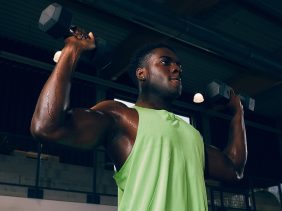Goblet Squat: Tips and tricks to make yours the most effective
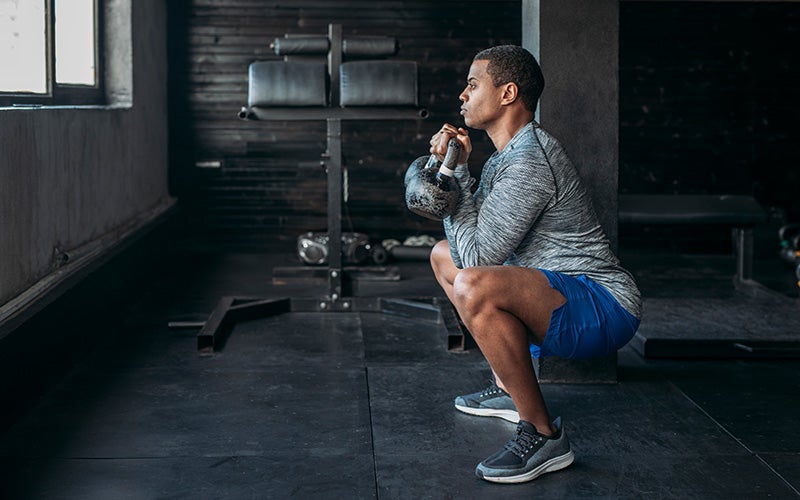 ©FreshSplash
©FreshSplash
There are countless squat variations, and the goblet squat is one of our favorites! Not only is it super effective, but also helps you to get the hang of the movement pattern of a classic squat using the barbell. But no matter your level of expertise, you should consider including goblet squats in your routine. Let’s get down to it and talk about how to do a goblet squat correctly and what other advantages – like improving your mobility! – this variation has to offer.
What is a Goblet Squat?
Goblet squats are squat variations usually performed with a lightweight dumbbell or a kettlebell. They resemble a front squat because the working weight stays in the front. The term alludes to the way the exerciser forms a “goblet” with their hands while holding the weight.
The inventor of the exercise, Dan John, is an American strength coach who holds the US record in the Olympic weight pentathlon. He developed the goblet squat so that he could teach his training clients and other athletes the correct execution of an overhead squat. According to John, once you’ve mastered the goblet squat, it’s easier to perform a classic squat or overhead squat correctly1.
This is a great exercise for both beginners and experienced athletes, and can be integrated into your workout as a warm-up or at the end of a workout to really max out with a high number of reps. This powerhouse works several muscle groups at the same time and efficiently exerts the core muscles as well as the lower body.
Our tip: To supplement your hard workout, strong muscles need a balanced diet. Getting enough protein contributes to both muscle maintenance and muscle mass gain and should definitely be a part of your nutrition plan. To supply your body with protein quickly, easily, and on-the-go, our Whey Protein is the perfect solution.
What are the benefits of goblet squats?
How many times a day do you sit down and stand up again? The movement pattern of a squat is quite natural for us humans and relevant too. When done with additional weight, squats help you effectively build muscle mass and increase your strength, and they burn a lot of calories in the process.
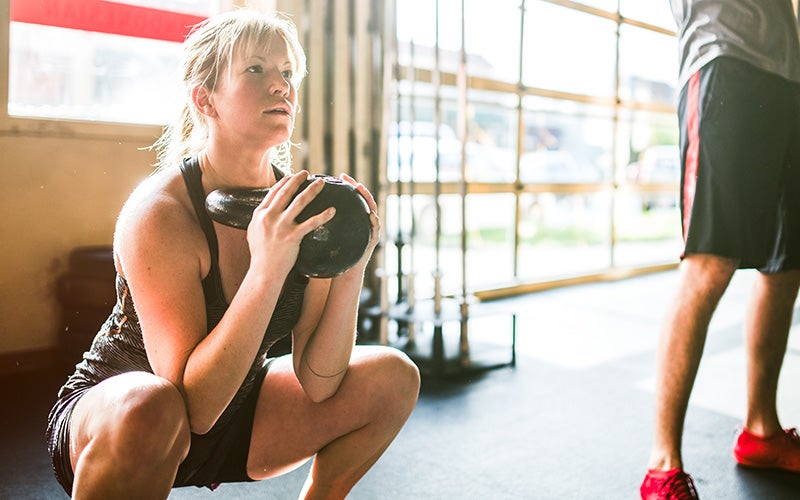
What are some further benefits of adding goblet squats to your sweat session? Here’s some more advantages in a nutshell:
More balance and depth
With goblet squats, you hold the weight in front of you, which makes the exercise somewhat easier to perform. There are a few reasons for this. First, dumbbells and kettlebells are both pretty compact weights, which are easier to hold compared to a barbell.
Also, executing a goblet squat requires a bit of balance so you don’t fall forward so easily. Keeping the dumbbell or kettlebell in front of your chest helps you sink deeper into the squat because you have to keep your upper body upright instead of leaning forward.
Easier to learn
If you want to learn how to do a squat properly, you might want to start with perfecting an air squat. If you’re confident with those and you want to add an additional weight, you can take on the goblet squats next. Risk of injury increases when you add weight, so, as with any other exercise, make sure you have your technique down before adding any! The movement pattern of a squat is complex and requires good coordination and cooperation of your muscles to have correct form. To help you transition from an air squat to a loaded squat, goblet squats give you more control over your body and the extra weight.
Our tip: Getting started can be the hardest part! Want to know how to do an air squat correctly to get the most out of your workout? Read our article on how to do Air Squats correctly.
A good alternative after an injury or a break from training
Another great advantage of this squat variation is being able to slowly reload the movement pattern after, for example, an injury or a break from exercising, without putting too much pressure on your joints or spine.
Perfect for a home workout
You don’t need a gym to do goblet squats — you can do them with an extra weight at home or anywhere else you want. No more excuses!
Efficient multitaskers
Goblets are a free, multi-joint exercise that target many muscles at once and are great for your muscle endurance. Among the muscles trained are your deep core muscles, which work to stabilize you. You’ll also burn a good number of calories, work on your coordination, and release testosterone. An increased testosterone level stimulates protein metabolism and supports muscle growth.
Easier to keep your knees & ankles stable
One common mistake when doing a classic squat is letting your knees fall in towards each other during the movement. Some athletes tend to do this when they increase their working weight, for example. In a goblet squat, your elbows should move between your knees as you go lower. This usually forces your knees to open outward without having to think too much about it2.
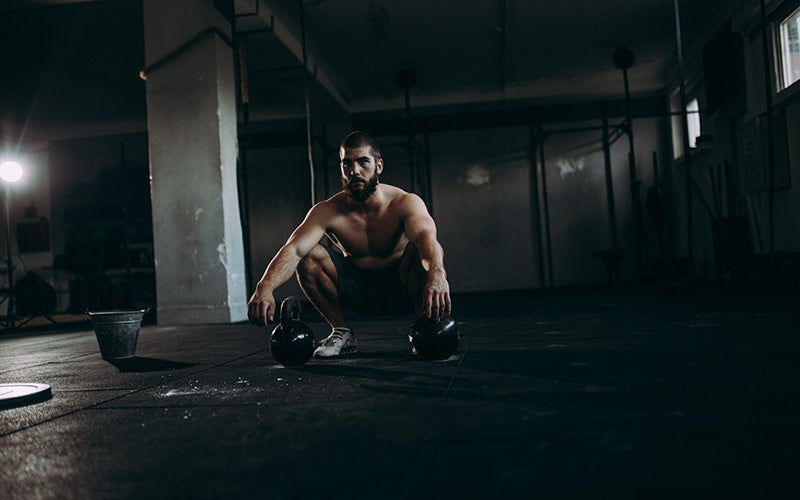
Works as mobility exercise, too
When you perform the exercise correctly, your knee joints will sit higher than your hip joints and your heels will stay on the ground. This requires good mobility in the hips and ankles. One way to specifically train your mobility is goblet squat prying.
To do this, get into the lowest position of a goblet squat and stay there. Press your elbows against the inside of your knees so that your knees don’t knock inward. While doing this, hold a small counterweight at chest level. The best way to do these is to imagine that you’re mentally pushing your pelvis apart. Then shift your weight back and forth from one side to the other.
What muscles does the goblet squat train?
A great thing about goblet squats is that they work both the upper and lower body, with most of the focus on the thighs, glutes, and core.
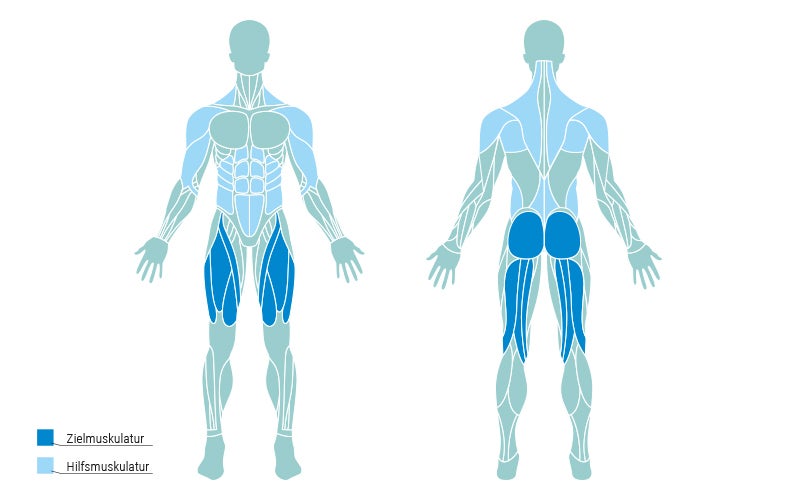
Primary trained muscles at a glance:
- Musculus quadriceps femoris / thigh extensor / quadriceps: Your thigh is responsible for extending your knees. It’s what helps you straighten your knee when you straighten up from a squat.
- Ischiocrural muscles / posterior muscles / hamstrings: Your hamstrings are made up of a total of three muscles and mainly bend the legs and extend the hips. They what enable you to bend your knees during the goblet squat and support you during hip extension.
- Gluteus maximus / glutes: Your glutes have the task of extending your hips when you come up and turning your legs outward.
Secondary trained muscles at a glance:
- Musculus erector spinae / back extensor: Your back extensor stretches your back and keeps it straight during the movement.
- Abdominal muscles: Your abdominal muscles stabilize you. Always remember to tighten your entire core.
- Upper back, shoulders, and biceps: These muscles help you hold the weight and are constantly engaged.
Perform goblet squat correctly
Whether you perform your goblet squat with a dumbbell or do a kettlebell goblet squat is just up to your personal preference and what equipment you have available to you. Use a lighter weight until you’ve really nailed the exercise. Only then should you gradually increase the load.
- Assume the starting position for a squat. To do this, stand with your feet about hip-width apart. Your feet should be in line with your knees and your knees should be slightly bent. Distribute your weight over your entire foot. Hold a dumbbell or kettlebell with both hands at chest level. Keep your arms close to your body and pointed towards the floor.
- Lower straight down while making sure your knees go a bit outward. You’ll do this by bending at the hips. Keep your upper body upright and keep the weight close to your body the entire time. This will also help you maintain your balance. Your upper body should barely move, while your legs, hips, and lower back form one unit.
- Inhale as you go low. Lower yourself slowly and in a controlled manner into the goblet squat. As you lower, your elbows will slide themselves between your knees. At the lowest point, your hip joints are lower than your knee joints. Keep your spine long and your torso upright. Your heels stay on the ground and all your core muscles are fully engaged.
- Then come back up again. Again, actively press the knees outward and exhale as you come up. Press your heels down into the floor to bring yourself to an upright stance, and the starting position.
Of course, you can also experiment with the stance width to find the optimal foot position for you.
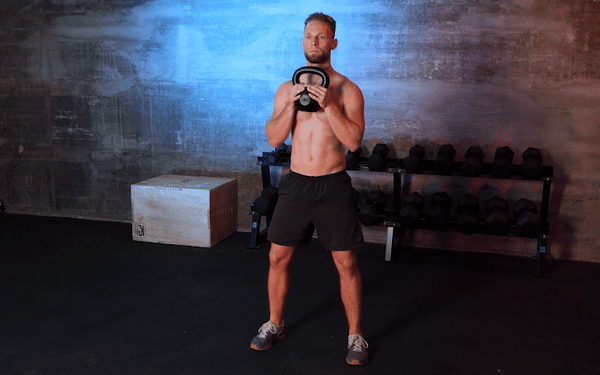
Common goblet squat mistakes
Even though the goblet squat is easier than a barbell squat, it’s still a complex exercise. If mistakes creep in, they can result in injuries. So, to help you get the best form out of your goblet squat, here are the most common mistakes and tips to avoid them.
#1 Dropping down
Actively lower yourself down into the squat. Try to emphasize the eccentric phase and go deep slowly and in a controlled manner instead of letting yourself fall into your ligaments and tendons. Be sure you aren’t working with heavier weights than you can handle without sacrificing form.
#2 Your hips are coming up faster than your shoulders
Try to come up explosively from the lower position. Keep your upper body upright. Your center of gravity should remain in the middle.
#3 Not keeping your torso upright
If you aren’t engaged enough in your upper back, your shoulders might drop forward, which will affect your whole upper body and might even cause a back injury. Tighten your core. Your chest should point straight out. Pull your shoulder blades back and down.
#4 Stopping too high
Don’t only go halfway. How deep you go depends, among other things, on your individual anatomy, e.g. how long your thigh is. With goblet squats it should be easy for you to go deeper. At the lowest position, your hips should be lower than your knees.
Our tip: Want to improve the depth of your squat? In addition to incorporating some targeted mobility exercises for your hips and ankles, you can also try the squat with your heels raised. This changes the angle and allows you to push your knees further forward and lower your hips deeper. To do this, place a large weight plate, wedge, or large book under your heels. Make sure that the elevation is stable and that you don’t slip. Special weightlifting shoes, if you have them, can also provide heel elevation.
Summary
- Goblet squats are a squat variation performed with a dumbbell or kettlebell in front of you
- They can prepare beginners to squat with a barbell by training the movement pattern of a squat in a simplified way.
- Advantages of goblet squats are finding more depth and balance in your squats, improving your mobility. They’re super efficient on your muscles and the movement required to execute them is useful for everyday. Plus, you can easily do them outside of a gym.
- Common mistakes include rounding your torso, only going halfway, lifting the heels, and “dropping” when lowering instead of moving intentionally.
Sources for this article
We at foodspring use only high-quality sources, including peer-reviewed studies, to support the facts within our articles. Read our editorial policy to learn more about how we fact-check and keep our content accurate, reliable, and trustworthy.































